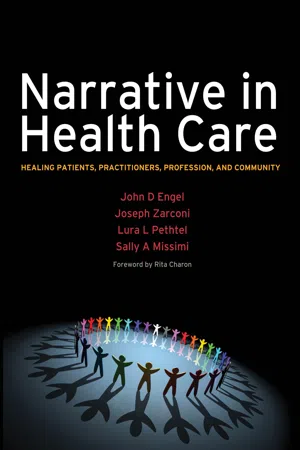
Narrative in Health Care
Healing Patients, Practitioners, Profession, and Community
- 272 pages
- English
- ePUB (mobile friendly)
- Available on iOS & Android
Narrative in Health Care
Healing Patients, Practitioners, Profession, and Community
About This Book
Narrative medicine has developed an identity already. Clinicians of many disciplines are being summoned to a practice that recognizes patients by receiving their accounts of self. Starting from different positions, the four authors have converged in a strong and shared commitment to narrative health care. They conceptualize narrative health care practices within frameworks derived from the social sciences and psychology, and, to a lesser degree, phenomenology and autobiographical theory. They relate the development of narrative medicine to relationship-centered care, patient-centered care, and complex responsive process of relating theory, positing that narrative medicine can help clinicians to develop the skills required to practice relationship-centered care. The book details - with exercises, resource texts, and abundant scholarly apparatus - how these skills can be developed and strengthened. This work will change health care. Because of its scholarly rigor, its multi-voiced sources, and its highly practical features (lists, activities, key ideas and key references, primary texts written by health care professionals and patients), this work will be a guide in the field for those who practice medicine or nursing or social work. The book establishes that there is a field to be practised, a need to practise it, and a means to develop the wherewithal to do so.
Frequently asked questions
Information
PART 1
Historical Context, Genealogy, and Current Viewpoints
CHAPTER 1
Medicine, Medical Practice, and Knowledge
KEY IDEAS
- Practices and values of modern medicine have their foundation in the social and intellectual contexts of the mid-nineteenth century.
- US medicine during the nineteenth century was heavily influenced by Scottish and French clinical medicine and German medical science.
- US physicians returning from training in Germany believed that science was the key to medical progress as well as reforms in medical education.
- Medicine embraced a form of seventeenth-century science built upon the work of Bacon, Descartes, and Newton, and based on empirical observation, material mechanisms, reductionism, determinism, and dualism.
- This seventeenth-century paradigm evolved into the dominant system of thought that propelled future medical scientists and physicians to act as objective observers striving to eliminate subjective features of their practices.
- This stance laid the foundation for a biophysical approach to the patient.
- Biomedicine fosters an approach to suffering that values increasing levels of abstraction and distance from the lived experience of the sufferer – an approach that is abstract, context free, and impersonal.
- The critique of biomedicine strives to reconnect mind with body and return the patient as a reflecting and reflexive self to the center of the clinical relationship.
A CLINICAL STORY
THE MAKING OF MODERN MEDICINE
Table of contents
- Cover
- Title Page
- Copyright Page
- Dedication
- Table of Contents
- Foreword
- About the Authors
- Acknowledgements
- Introduction
- PART 1 Historical Context, Genealogy, and Current Viewpoints
- PART 2 Professional Performance Situations and Narrative Importance
- INTERLUDE: The Death of Ivan Ilyich
- PART 3 Narrative Competence and Its Outcomes
- PART 4 Personal Perspectives on Narrative in Health Care
- Afterword
- Glossary
- Author index
- Subject index